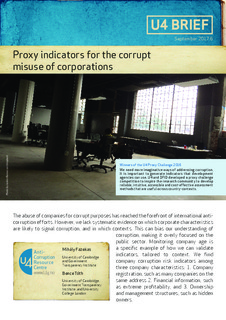| dc.description.abstract | Winners of the U4 Proxy Challenge 2016
We need more imaginative ways of addressing corruption. It is important to generate indicators that development agencies can use. U4 and DFID developed a proxy challenge competition to inspire the research community to develop reliable, intuitive, accessible and cost-effective assessment methods that are useful across country-contexts.
The abuse of companies for corrupt purposes has reached the forefront of international anti-corruption efforts. However, we lack systematic evidence on which corporate characteristics are likely to signal corruption, and in which contexts. This can bias our understanding of corruption, making it overly focused on the public sector. Monitoring company age is a specific example of how we can validate indicators, tailored to context. We find company corruption risk indicators among three company characteristics: 1. Company registration, such as many companies on the same address 2. Financial information, such as extreme profitability, and 3. Ownership and management structures, such as hidden owners.
The abuse of companies for corrupt purposes has reached the forefront of international anti-corruption efforts. However, we lack systematic evidence on which corporate characteristics are likely to signal corruption, and in which contexts. This can bias our understanding of corruption, making it overly focused on the public sector. Monitoring company age is a specific example of how we can validate indicators, tailored to context. We find company corruption risk indicators among three company characteristics: 1. Company registration, such as many companies on the same address 2. Financial information, such as extreme profitability, and 3. Ownership and management structures, such as hidden owners.
How to measure company corruption risks
Recent scandals have brought to light the scale and diverse forms of abusing individual companies and extensive corporate networks for extracting cor | |
